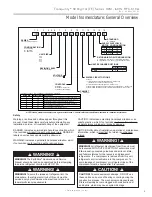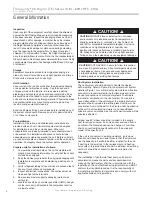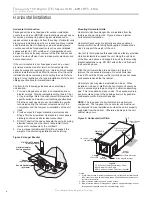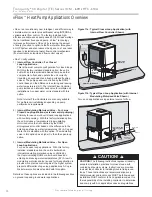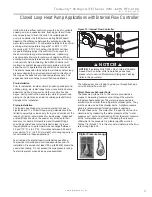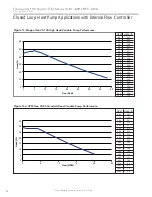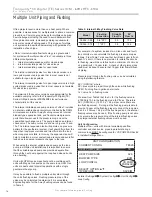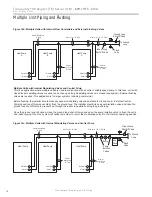
4
G e o t h e r m a l H e a t i n g a n d C o o l i n g
Tranquility
®
30 Digital (TE) Series IOM - 60Hz HFC-410A
R e v. : 2 9 M a y, 2 0 1 5 J
General Information
CAUTION!
CAUTION!
CAUTION!
CUT HAZARD - Failure to follow this caution
may result in personal injury. Sheet metal parts may have
sharp edges or burrs. Use care and wear appropriate
protective clothing, safety glasses and gloves when
handling parts and servicing heat pumps.
Inspection
Upon receipt of the equipment, carefully check the shipment
against the bill of lading. Make sure all units and accessories
have been received. Inspect the packaging of each unit, and
inspect each unit for damage. Insure that the carrier makes
proper notation of any shortages or damage on all copies of
the freight bill and completes a common carrier inspection
report. Concealed damage not discovered during unloading
must be reported to the carrier within 15 days of receipt of
shipment. If not
fi
led within 15 days, the freight company can
deny the claim without recourse. Note: It is the responsibility of
the purchaser to
fi
le all necessary claims with the carrier. Notify
your equipment supplier of all damage within
fi
fteen (15) days
of shipment.
Storage
Equipment should be stored in its original packaging in a
clean, dry area. Store units in an upright position at all times.
Stack units a maximum of 3 units high.
Unit Protection
Cover units on the job site with either the original packaging
or an equivalent protective covering. Cap the open ends
of pipes stored on the job site. In areas where painting,
plastering, and/or spraying has not been completed, all due
precautions must be taken to avoid physical damage to the
units and contamination by foreign material. Physical damage
and contamination may prevent proper start-up and may
result in costly equipment clean-up.
Examine all pipes,
fi
ttings, and valves before installing any of
the system components. Remove any dirt or debris found in
or on these components.
Pre-Installation
Installation, Operation, and Maintenance instructions are
provided with each unit. Horizontal equipment is designed
for installation in an attic or crawl space. Other unit
con
fi
gurations are typically installed in a mechanical closet
or basement. The installation site chosen should include
adequate service clearance around the unit. Before unit start-
up, read all manuals and become familiar with the unit and its
operation. Thoroughly check the system before operation.
Prepare units for installation as follows:
1. Compare the electrical data on the unit nameplate with
ordering and shipping information to verify that the correct
unit has been shipped.
2. Keep the cabinet covered with the original packaging until
installation is complete and all plastering, painting, etc. is
fi
nished.
3. Verify refrigerant tubing is free of kinks or dents and that it
does not touch other unit components.
4. Inspect all electrical connections. Connections must be
clean and tight at the terminals.
5. Remove any blower support packaging (water-to-air
units only).
6. Locate and verify any hot water generator (HWG), hanger,
or other accessory kit located in the compressor section
or blower section.
Duct System Installation
The duct system should be sized to handle the design
air
fl
ow quietly. Refer to Figure 6 for horizontal duct system
details or Figure 1 for vertical duct system details. A
fl
exible
connector is recommended for both discharge and return
air duct connections on metal duct systems to eliminate
the transfer of vibration to the duct system. To maximize
sound attenuation of the unit blower, the supply and return
plenums should include internal
fi
berglass duct liner or be
constructed from ductboard for the
fi
rst few feet. Application
of the unit to uninsulated ductwork in an unconditioned
space is not recommended, as the unit’s performance will be
adversely a
ff
ected.
At least one 90° elbow should be included in the supply
duct to reduce air noise. If air noise or excessive air
fl
ow is
a problem, the blower speed can be changed. For air
fl
ow
charts, consult catalog speci
fi
cations for the series and
model of the speci
fi
c unit.
If the unit is connected to existing ductwork, a previous
check should have been made to insure that the ductwork
has the capacity to handle the air
fl
ow required for the unit.
If ducting is too small, as in the replacement of a heating
only system, larger ductwork should be installed. All existing
ductwork should be checked for leaks and repaired as
necessary.
CAUTION!
DO NOT store or install units in corrosive
environments or in locations subject to temperature or
humidity extremes (e.g., rooftops, etc. See Tables 12a
and 12b for acceptable temperature ranges). Corrosive
conditions and high temperature or humidity can
signi
fi
cantly reduce performance, reliability, and service
life. Always move and store units in an upright position.
Tilting units on their sides may cause equipment damage.
The installation of geothermal heat pump units and all
associated components, parts and accessories which
make up the GHP system shall be in accordance with the
regulations of ALL authorities having jurisdiction and MUST
conform to all applicable codes. It is the responsibility of
the installing contractor to determine and comply with ALL
applicable codes and regulations.



